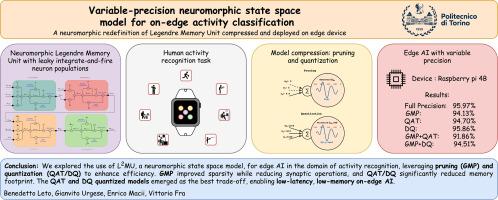Variable-precision neuromorphic state space model for on-edge activity classification
IF 6.2
2区 计算机科学
Q1 COMPUTER SCIENCE, THEORY & METHODS
Future Generation Computer Systems-The International Journal of Escience
Pub Date : 2025-10-11
DOI:10.1016/j.future.2025.108193
引用次数: 0
Abstract
Neuromorphic computing is rising as a promising paradigm for efficient AI, leveraging event-driven computation to achieve low-power and high-performance computing. Due to the real-time processing required by edge devices with minimal power consumption, optimizing neuromorphic models for on-edge applications can be crucial to address the issue of power efficiency and resource-constraint devices. This work explores the definition of a neuromorphic state space model and its deployment on non-dedicated hardware. Structured sparsity and quantization techniques are leveraged to enhance the model’s efficiency. By compressing synaptic operations and memory footprint, we demonstrate how neuromorphic models can be adapted for on-edge deployment, ensuring low-latency and memory efficient inference. This study highlights the potential of neuromorphic models as a scalable solution for real-world embedded systems with limited resources.

边缘活动分类的变精度神经形态状态空间模型
神经形态计算作为高效人工智能的一个有前途的范例正在崛起,利用事件驱动的计算来实现低功耗和高性能的计算。由于边缘设备需要以最小的功耗进行实时处理,因此优化边缘应用的神经形态模型对于解决功率效率和资源约束设备的问题至关重要。这项工作探讨了神经形态状态空间模型的定义及其在非专用硬件上的部署。利用结构化稀疏性和量化技术来提高模型的效率。通过压缩突触操作和内存占用,我们展示了神经形态模型如何适应边缘部署,确保低延迟和内存高效推断。这项研究强调了神经形态模型作为现实世界中资源有限的嵌入式系统的可扩展解决方案的潜力。
本文章由计算机程序翻译,如有差异,请以英文原文为准。
求助全文
约1分钟内获得全文
求助全文
来源期刊
CiteScore
19.90
自引率
2.70%
发文量
376
审稿时长
10.6 months
期刊介绍:
Computing infrastructures and systems are constantly evolving, resulting in increasingly complex and collaborative scientific applications. To cope with these advancements, there is a growing need for collaborative tools that can effectively map, control, and execute these applications.
Furthermore, with the explosion of Big Data, there is a requirement for innovative methods and infrastructures to collect, analyze, and derive meaningful insights from the vast amount of data generated. This necessitates the integration of computational and storage capabilities, databases, sensors, and human collaboration.
Future Generation Computer Systems aims to pioneer advancements in distributed systems, collaborative environments, high-performance computing, and Big Data analytics. It strives to stay at the forefront of developments in grids, clouds, and the Internet of Things (IoT) to effectively address the challenges posed by these wide-area, fully distributed sensing and computing systems.

 求助内容:
求助内容: 应助结果提醒方式:
应助结果提醒方式:


